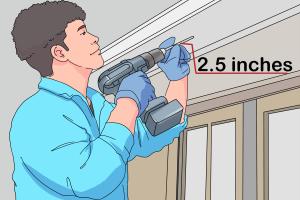Ultimate Guide to Repairing Rotted Eaves: Step-by-Step Solutions

-
Quick Links:
- Introduction
- Understanding Eaves
- Causes of Rotted Eaves
- Signs of Eaves Damage
- Tools and Materials Needed
- Step-by-Step Repair Process
- Prevention Tips for Eaves
- Case Studies
- Expert Insights
- FAQs
- Conclusion
Introduction
Eaves play a crucial role in protecting your home from water damage. However, like any part of your home, they can suffer from rot due to various environmental factors. In this comprehensive guide, we will delve deep into the process of repairing rotted eaves, ensuring your home remains safe and sound.
Understanding Eaves
Eaves are the edges of the roof that overhang the walls of a house. They serve several essential functions, including:
- Redirecting rainwater away from the house
- Providing shade and reducing heat gain
- Enhancing the aesthetic appeal of your home
Causes of Rotted Eaves
Rotted eaves can result from several issues, including:
- Poor drainage: If gutters are clogged, water can overflow and pool around the eaves.
- Moisture accumulation: Prolonged exposure to rain and humidity can lead to wood rot.
- Insect damage: Pests like termites can weaken the wood structure.
Signs of Eaves Damage
Recognizing the signs of rotted eaves early can save you time and money. Look for:
- Visible rot or soft spots in the wood
- Discoloration or staining
- Mold or mildew growth
- Cracks or warping
Tools and Materials Needed
Before starting your repair, gather the necessary tools and materials:
- Safety goggles and gloves
- Hammer and nails
- Screwdriver
- Wood chisel
- Rot-resistant wood (e.g., cedar or redwood)
- Wood filler
- Paint or sealant
Step-by-Step Repair Process
Here’s a detailed process to repair rotted eaves effectively:
Step 1: Inspect the Damage
Carefully inspect the eaves to assess the extent of the damage.
Step 2: Remove Rotted Sections
Using your chisel and hammer, remove any rotted wood. Ensure that you cut back to solid wood.
Step 3: Prepare the Area
Clean the area thoroughly, removing any debris, dust, or old paint.
Step 4: Cut and Fit New Wood
Cut new wood to fit the area. Ensure it matches the original eaves in size and style.
Step 5: Attach the New Wood
Secure the new wood in place with nails or screws. Make sure it’s firmly attached.
Step 6: Fill Gaps and Sand
Use wood filler to fill any gaps. Once dry, sand the area to ensure a smooth finish.
Step 7: Paint and Seal
Finally, paint or seal the new wood to protect it from future damage.
Prevention Tips for Eaves
Taking preventive measures can extend the life of your eaves:
- Regularly clean gutters and downspouts to prevent clogging.
- Inspect your roof and eaves annually for signs of damage.
- Ensure proper drainage around your home to reduce moisture accumulation.
Case Studies
Here are a few case studies illustrating successful eaves repair:
Case Study 1: A Family Home in Ohio
A family noticed discoloration under their eaves. After inspecting, they found extensive rot. Following the steps outlined in this guide, they successfully repaired the damage and prevented future issues.
Case Study 2: A Historic House in Massachusetts
Owners of a historic home faced significant eaves damage due to age. They opted for professional help but used the techniques from this guide to ensure the repairs matched the original style of their home.
Expert Insights
We consulted a local roofing expert, John Smith, who emphasized the importance of regular maintenance:
"Many homeowners overlook the eaves, but they are essential for protecting your home. Regular checks can save a lot of trouble down the line."
FAQs
1. How can I tell if my eaves are rotting?
Look for soft spots, discoloration, or visible mold.
2. Can I repair rotted eaves myself?
Yes, if you have basic DIY skills and tools, you can follow the steps outlined in this guide.
3. What type of wood is best for eaves repair?
Use rot-resistant wood such as cedar or redwood for durability.
4. How often should I check my eaves?
At least once a year, or more frequently in heavy rain seasons.
5. Can I prevent rot in my eaves?
Yes, regular maintenance and ensuring proper drainage can help prevent rot.
6. What should I do if the rot is extensive?
If the rot is severe, consider hiring a professional for assessment and repair.
7. Is it necessary to paint my eaves after repair?
Yes, painting or sealing helps protect the wood from moisture and UV damage.
8. What tools will I need for the repair?
You’ll need safety gear, a hammer, screwdriver, chisel, and wood filler.
9. How long does eaves repair typically take?
The repair can take a few hours to a day, depending on the extent of the damage.
10. What are the costs associated with eaves repair?
Costs can range from minimal DIY expenses to several hundred dollars for professional help, depending on complexity.
Conclusion
Repairing rotted eaves is an essential home maintenance task that can protect your property from further damage. By following this detailed guide, you can ensure that your home's eaves are restored to their former glory, enhancing both the aesthetics and functionality of your home. Remember, regular inspection and maintenance are the keys to longevity.